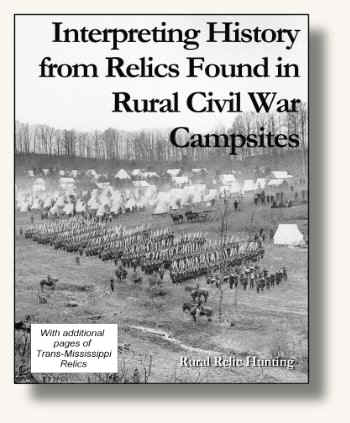
Interpreting History from Relics Found in Rural Civil War Campsites
 |
| CLICK TO ENLARGE |
![]() his
is the second of a series of "how to" manuals on relic hunting in
rural Civil War campsites. Once a prospective campsite is found, the authors
provide methods to successfully interpret the campsite history from its relics.
his
is the second of a series of "how to" manuals on relic hunting in
rural Civil War campsites. Once a prospective campsite is found, the authors
provide methods to successfully interpret the campsite history from its relics.
These methods allow for an estimate of the overall size of the campsite and the delineation of various camp subdivisions (officers area, enlisted area, commissary, stables and livery, sutler store and hospital, if present) from the nature of the excavated relics of the camp.
The authors show how to setup and use GPS units in relic hunting so that any newly-found campsite can be systematically searched. The GPS units provide the surface location of any relic found in the campsite.
Using PC software, GPS waypoint locations from the campsite can be plotted on topographic map images or air photos. The size and subdivisions of the camp will begin to emerge from this plot.
The manual shows that the layout of most Union and Confederate camps was identical and usually made up of the same subdivisions. The authors provide an extensive list of typical and rare campsite relics and show how to interpret their typical subdivision location. A special set of guidelines are also presented to further enhance the interpretation of the history of the campsite.
Methods and examples are provided throughout the manual and several Civil War vintage photographs are interpreted in light of the principles presented in this manual. Several Pages of "finds" within the Trans-Mississippi are also included.
This manual may be purchased from:
David Poché Associates
573-814-9684 call for terms and details
Other manuals of this series: "Finding Civil War Campsites in Rural
Areas"
REVIEWS
Review by L. David Keith, Dixie Metal Detectors:
![]() After the success of "Finding Civil War Campsites in Rural Areas"
(Volume I),
After the success of "Finding Civil War Campsites in Rural Areas"
(Volume I),
author Dave Poche and Associates has released a second volume titled;
"Interpreting History from Relics Found in Civil War Campsites-Rural
Relic
Hunting." This larger volume is packed with outstanding information on how
to
systematically search a Civil War Camp using the modern GPS (Global
Positioning Satellite). And, your previously gathered search tools: Topo and
aerial maps, Internet sources; publications, books, and diaries (consult
Volume I).
Divided into three parts, "Interpreting History from
Relics Found
in Civil War Campsites" (Volume 2) is divided into three parts, which contains 35
subparts covering how Infantry, Cavalry and Artillery camps were set up.
Included are sites in which the Officers, Enlisted men, Sutler, Commissary and
Livery occupied. Many actual Civil War photographs are included providing
outstanding reference, as well as illustrations on camp layouts. Tents used
by Officers and Enlisted men are covered in text, illustration and
photographs. Included are three subparts on how to use a GPS to plot and
record data, even how to track your every move while searching a camp site.
This data can be downloaded at home to discover "loop holes" within
your
search pattern, so you can return to search missed or overlooked areas.
Volume II also covers Camp sizes, length of occupation, dating Campsites, how
to discover who camped there, and how to search the different Camps within
branches of service. Once you have found your Camp and begun a systematic
search, your relics can tell you a great deal about the men and animals that
occupied its ground.
Volume II covers this in great detail. This is one of the most complete books
on documenting relics and their history I have ever read.
Several subparts are dedicated to interpreting what a dug relic can
yield as to who lost it and when it was lost. Also included are outstanding
graphs on subdividing relics into categories: Officers, Enlisted men and
Peripheral areas. This guide will help you interpret what area of a camp you
are in.
Even dedicated relic hunters who own their own personal Library with
years of experience, will gain a lot of information. I highly recommend this
book to anyone who searches for history, whether just a history buff or hard
core metal Detectorist. Consider Volume I and II and must have for those who
pursue our Civil War Ancestors past.